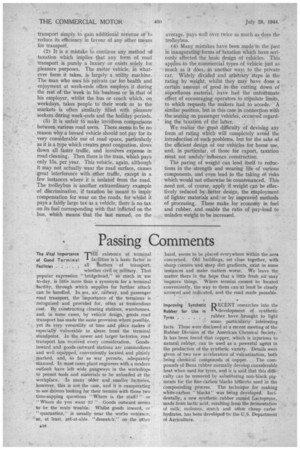Passing Comments
Page 18

Page 19

If you've noticed an error in this article please click here to report it so we can fix it.
The Vital Importance HE existence of terminal of Good Terminal I facilities is a basic factor in Facilities all ?natters of transport,
whether civil or military. That popular expression "bridgehead," so much in use to-day, is little more than a synonym for a terminal facility, through which supplies for further attack can be handled. In sea, air, railway, and passenger road transport, the importance of the terminus is recognized and provided for, often at tremendous cost. By constructing clearing stations, warehouses, and, in some cases, by vehicle design, goods road transport has made the same provision where possible, yet its very versatility of time and place makes it especially Vulnerable to abuse from the terminal standpoint. In the newer and larger factories, road transport has received every consideration. Goodsinward and goods outward stations are commodious and well equipped, conveniently located and plainly marked, and, so far as war permits, adequately manned. In most cases plant engineers with a modern outlook have left wide gangways in the workshops to permit tools and materials to be unloaded at the workplace. In many older and smaller factories, however, this is not the case, and it is exasperating to see drivers looking for their terminiwith those two time-sapping questions "Where is the stuff? " or " Where do you want it?" Goods outward seems to be the main trouble. Whilst goods inward, or " quarantine," is usually near the works entrance, or, at least, get-at-able. "despatch." on the other hand, seems to be placed everywhere within the area concerned. Old buildings, set close together, with sharp corners and steep dirt gradients, exist in some instances and make matters worse. We leave the matter there in the hope that a little fresh air may improve things. Where termini cannot be located conveniently, the way to them can at least be clearly arrowed and indicated, and the road made passable.
Improving Synthetic ECENT researches into the
Rubber for Use in I X development of synthetic
Tyres rubber have brought to light some particularly interesting facts. These were disclpsed at a recent meeting of the Rubber Division of the American Chemical Society. It has been found that copper, which is injurious to natural rublapr, can be used as a powerful agent in the production of the synthetic variety. Details were given of two new accelerators of vulcanization, both being chemical compounds of copper. The compounds of Buna rubber normally develop considerable heat when used for tyres, and it is said that this difficulty can be removed by substituting non-black pigments for the fine-carbon blacks hitherto used in the compounding process. The technique for making white-carbon " blacks " was being developed. Incidentally, a new synthetic rubber named Lactoprene, made from lactic acid, resulting from the fermentation of milk, molasses, starch and other cheap carbo hydrates, has been developed by the U.S. Department of Agriculture. Pig ncreise in Road OR what IS, we believe, the
Accidents During I firist -time,the official
May monthly figures of road fatali
ties show the number of people killed by vehicles in the use of the Armed Forces. For May the full list of types of vehicle and numbers of persons killed is as follows : --Armed Services, 263; Civil Defence and National Fire Service, 7; publicservice and.lackney, 80; goods, 117; private cars, 43; motorcycles, 21; cycles, 87; others, 14; total, 632. This last figure is an increase of 201 on that of May last year, and it is notable that the majority occurred in Southern England. This is probably due to the tremendous congregation 'of road transport involved in the preparations. for D-Day. The corresponding umber of injured for the respective months rose ftom 8,972 to 11,521. The figures do not imply that the drivers of the vehicles primarily. involved were culpable or responsible for the accidents. AN incident observed on the road recently goes far to indicate that the net savings of liquid fuel to be derived by conversion to producer gas may not be so much as is expected, taking into consideration only the direct economies from individual vehicles so converted. ThR scene was on a moderately steep hill, the road some-. what narrow and winding, a road on which it is impossible for one vehicle to overtake another for some considerable distance. A queue of 10 vehicles was proceeding up the hill at about 5 m.p.h. The foremost was running on producer gas and was obviously setting the pace for the other nine, which were all either petrol or oil driven. It is quite conceivable that the amount of liquid fuel thus wasted was far more than that saved over a considerable distance by the converted vehicle. This sort of thing frequently happens in country districts.
Producer-gas Vehicle Holds Up Other Traffic




















































